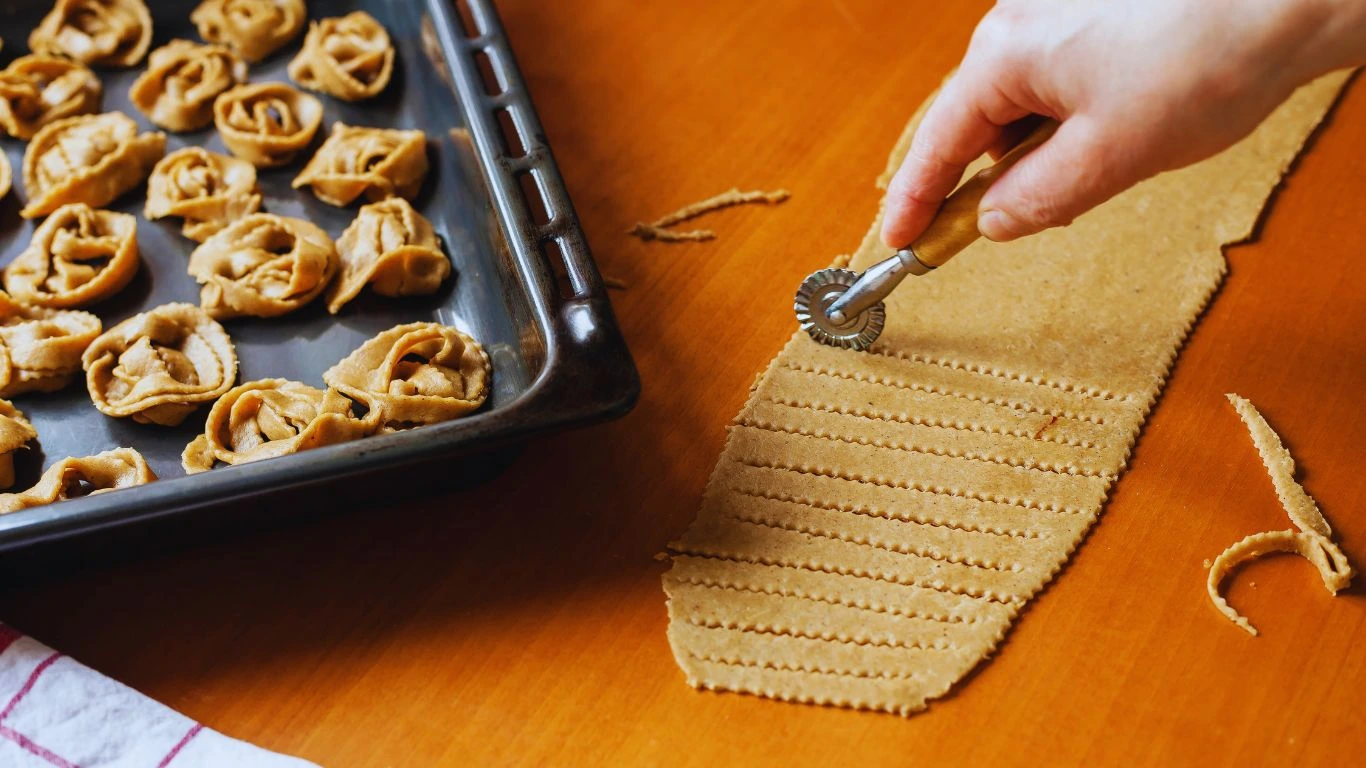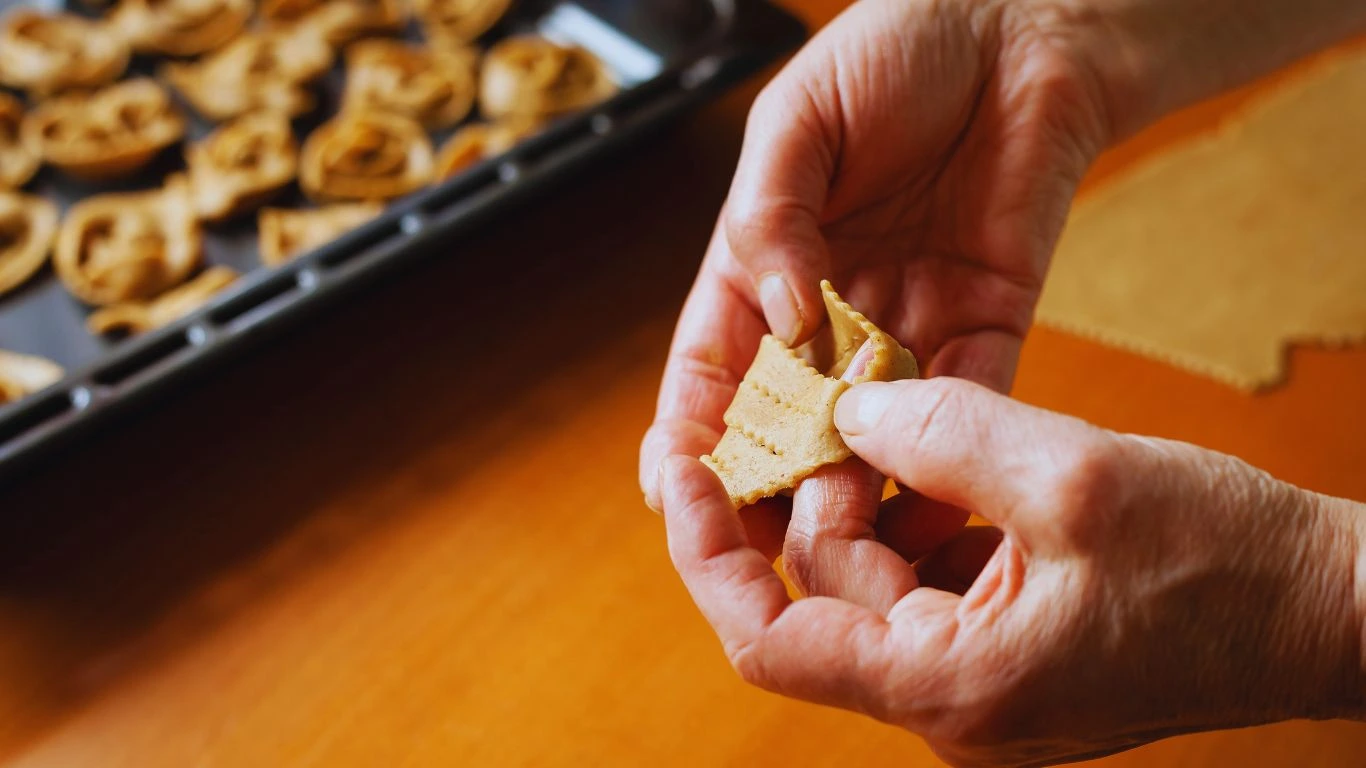Halwa Chebakia: Authentic Moroccan Sesame Cookies

Table of Contents
Halwa Chebakia is a beloved Moroccan dessert known for its deep sesame flavor and detailed design. These cookies, also called chebakia, are a key part of Moroccan cuisine. They are often enjoyed during holidays and special times.
Made with layers of phyllo dough, honey, and sesame seeds, they mix sweet and nutty flavors in every bite. This dessert is a true delight.
Halwa chebakia holds a special place in Moroccan culture, telling a story of tradition passed down through generations. Learning to make them connects you to centuries of culinary heritage. Their spiral shape and golden sesame coating make them as visually appealing as they are delicious.

Key Takeaways
- Halwa chebakia are sesame-filled Moroccan cookies tied to cultural celebrations.
- Key ingredients include phyllo dough, sesame seeds, honey, and orange blossom water.
- They symbolize joy and tradition in Moroccan households during Ramadan and Eid.
- Mastering their flaky texture requires careful layering and frying techniques.
- Sesame seeds give halwa chebakia their signature taste and nutritional richness.
A Brief Overview of Halwa Chebakia The Story Behind the Sweet Pastry What Sets This Traditional Moroccan Dessert Apart
Every bite of Halwa Chebakia tells a story that spans centuries. These moroccan sesame cookies are more than a sweet treat; they’re a treasured family heirloom. Their golden sesame-coated spirals bring the spirit of Moroccan celebrations and family traditions to life.
The Story Behind the Sweet Pastry
These cookies have deep roots in Morocco’s culinary history. They come from Islamic Andalusian cuisine. For generations, families have kept their recipes safe, often making them during Ramadan and weddings.
The process of making them is a labor of love. It involves rolling phyllo dough and hand-glazing each piece. This shows the patience and dedication that goes into them.
“They’re a labor of love, not just a recipe,”
VIEW: Moroccan-recipes
explains their role in Moroccan households as symbols of togetherness.
What Sets This Traditional Moroccan Dessert Apart
Here’s why moroccan sesame cookies are so special:
- Unique Design: Their spiral shape, resembling a rose or starburst, requires meticulous folding and pinching.
- Flavor Layers: Toasted sesame, honey, and orange blossom water blend into a balance of sweet, nutty, and floral notes.
- Cultural Significance: They’re often exchanged as gifts, embodying generosity and cultural pride.
Enjoying these cookies at a Moroccan feast or in your own kitchen is a treat. They mix history and flavor in every bite. moroccan sesame cookies are more than dessert; they’re a bridge to Morocco’s rich past.
Exploring the History of Authentic Moroccan Sesame Cookies
Halwa Chebakia’s story started centuries ago in Morocco’s lively markets and royal kitchens. It’s a traditional Moroccan dessert with roots in the medieval era. Trade and cultural exchanges shaped it.
By the 13th century, Andalusian refugees fleeing Spain introduced new techniques. They mixed these with local flavors, creating this famous pastry.
Key moments in its history include:
- Adoption of sesame from Middle Eastern traders along trans-Saharan routes
- Incorporation of rosewater and orange blossom water, symbols of Moroccan hospitality
- Role in Ramadan celebrations since the Islamic Golden Age
“These cookies are living history every bite connects us to our ancestors’ creativity,” says a Fez-based culinary historian. The design of the five-petaled shape mirrors Islamic geometric art, reflecting both faith and craftsmanship.
Over time, Halwa Chebakia went from a royal treat to a family favorite. Today, bakers still use old techniques like hand-twisting dough into spiral patterns. This keeps the dessert connected to its roots.
Its survival shows how cultural heritage can live on through generations. It’s a testament to the power of shared traditions.
Discover Halwa Chebakia (Moroccan Sesame Cookies) Origins in Moroccan Culinary Heritage Evolution Through Generations
Halwa Chebakia has a long history in Morocco. It comes from Islamic Andalusian traditions. Layers of dough filled with orange blossom water and honey were a sign of celebration.
Over time, it became a key part of Ramadan and weddings. It shows the rich flavors of Moroccan cuisine.
Origins in Moroccan Culinary Heritage
This sweet pastry recipe comes from Fes and Marrakech’s old markets. It was passed down through generations in Moroccan homes. It was seen as a sign of wealth, with sesame seeds and orange flowers showing the country’s rich land.
Artisans made special shapes, like the spiral, using old techniques. These methods have stayed the same for decades.
Evolution Through Generations
Today, Halwa Chebakia still honors its roots but also changes. Modern kitchens mix old ingredients with new ideas. Here are some changes:
- Hand-rolled dough is now made with kitchen tools for better precision
- More organic sesame is used for health reasons
- Some bakers try new flavors like rosewater or cardamom
“The heart of Chebakia is in finding balance,” says Chef Laila Benjelloun of Marrakech. “Even with new techniques, the recipe’s true spirit stays connected to Morocco’s heritage.”
Ingredients and Essential Tools for Your Recipe Key Ingredients for Authentic Flavor MustHave Kitchen Tools for Homemade Halwa Chebakia
To make homemade halwa chebakia, you need specific ingredients and tools. Each one is important for getting the authentic Moroccan taste. Start by getting these essentials to make your dish just like the traditional one.
Key Ingredients for Authentic Flavor
Choosing the right ingredients is key for halwa chebakia’s unique taste. Here’s what you should use:
- Sesame paste: Choose unhulled tahini for a deeper nutty flavor.
- Butter or clarified butter: Adds richness to the dough’s texture.
- Orange blossom water: Adds floral notes vital to the dessert’s aroma.
- Semolina flour: Provides the dough’s distinct crumbly structure.
- Honey or sugar syrup: Use for dipping after frying to lock in sweetness.
Must-Have Kitchen Tools for Homemade Halwa Chebakia
These tools make the process easier and improve the results:
- Wooden rolling pin: Ideal for shaping dough layers without tearing.
- Heavy-bottomed skillet: Prevents burning during frying.
- Slotted spoon: Lifts cookies easily from hot oil.
- Measuring cups: Ensures precise ingredient ratios.
“The rolling pin’s width and oil temperature control are non-negotiable. These details define the pastry’s delicate layers.” – Chef Mohamed El Fassi, Moroccan culinary historian
Using the right sesame paste and tools ensures every bite is a taste of Morocco. With precision in tools and ingredients, your kitchen becomes a doorway to Morocco’s culinary traditions.
Easy Chebakia Recipe for Your Kitchen Adventure
Step into the vibrant world of moroccan cuisine with this simple recipe. These sesame cookies blend tradition and simplicity, perfect for home bakers. Gather your ingredients and tools, then follow these steps to recreate a taste of Morocco:
- Prepare the dough: Mix flour, sugar, melted butter, and a splash of orange blossom water. Knead until smooth, then let rest for 30 minutes.
- Shape the dough: Roll into thin ropes and twist into flower-like spirals. Brush with a honey mixture for shine.
- Bake to golden: Cook at 350°F (175°C) for 20-25 minutes until edges crisp. Cool on a rack.
- Finish with sesame: While still warm, dip cookies into melted honey and coat generously with sesame seeds.
Chefs in moroccan cuisine advise patience when shaping dough—allow it to rest for optimal texture. Serve these cookies as a sweet finale to meals or paired with mint tea. Adjust sweetness by tweaking honey quantities to suit your taste. This recipe bridges tradition and home cooking, making moroccan cuisine accessible in your kitchen. Enjoy every step of crafting this iconic treat!
Traditional Moroccan Dessert Techniques Mastering the Art of Sesame Cooking Secrets for a Perfect Sweet Pastry Texture
Every bite of authentic Moroccan sweets tells a story of generations of cooks. Making halwa chebakia is not just about ingredients. It’s about respecting the traditional techniques that have been passed down through Moroccan kitchens.
Mastering the Art of Sesame Cooking
To perfect sesame integration, follow these steps:
- Toast sesame seeds gently in a dry pan until fragrant, never scorched.
- Blend toasted seeds into a smooth paste, mixing with warm honey to avoid clumps.
- Shape the dough into spirals while still warm to lock in sesame’s nutty flavor.
Secrets to getting the perfect texture for sweet pastries

For the right texture:
- Rest dough 30 minutes before rolling to prevent cracking.
- Bake at 325°F (160°C) for 20-25 minutes until golden, avoiding overbrowning.
- Use a wooden rolling pin for even pressure, a staple in Moroccan kitchens.
These methods ensure your halwa chebakia mirrors the crisp, honey-glazed perfection of authentic Moroccan sweets. They blend tradition with hands-on skill. Precision in each step honors centuries of culinary tradition, turning simple ingredients into a dessert that tells a story.
How to Achieve Authentic Flavors in Halwa Chebakia
Getting the real taste of Halwa Chebakia begins with following the easy chebakia recipe closely. Pay attention to these steps to get it just right:
- Use fresh, lightly toasted sesame seeds for a strong nutty smell.
- Blend spices like cinnamon and orange blossom water in the right amounts—don’t let them overpower the honey.
- Shape the dough by hand to get an even bake and flaky texture.
| Flavor Element | Key Technique |
| Sesame Intensity | Toast seeds just before mixing |
| Honey Shine | Brush with warm, not boiling, honey to prevent burning |
| Spice Harmony | Add orange blossom water last to preserve fragrance |
“A single burnt seed ruins the batch—quality ingredients demand respect.”
Stick to the easy chebakia recipe but listen to your gut. The dough should maintain its form without falling apart.. Test the honey thickness on a small piece first. Remember, the key is patience, not rushing. These steps will make your kitchen a taste of Morocco.
Homemade Halwa Chebakia: Tips and Tricks Step-by-Step Preparation Insights Practical Advice from Moroccan Cuisine Experts
Mastering Halwa Chebakia comes down to perfecting the techniques. With these helpful tips, you’ll be able to recreate this authentic Moroccan treat right in your own kitchen
Step-by-Step Preparation Insights

- Shape the dough into flower-like petals gently to prevent cracking.
- Heat the oil until it shimmers without reaching the smoking point—drop in a small piece of dough to test it first.
- Brush warm cookies with syrup immediately to lock in moisture.
- Let them cool completely before stacking to avoid getting wet.
Practical tips from Moroccan cuisine experts
Chefs say it’s all about keeping it simple and true to tradition:
- Use clarified butter (ghee) for deeper flavor.
- Soak almonds overnight for softer texture in fillings.
- Store extras in airtight containers lined with parchment paper.
| Common Issue | Solution |
| Dough too sticky | Chill it for 10 minutes before rolling. |
| Uneven frying | Use a slotted spoon to turn cookies gently. |
Trying out these methods will make your Moroccan desserts even more special. Follow these steps to make a classic treat that celebrates centuries of tradition.
Moroccan Cuisine: Beyond Halwa Chebakia
Moroccan cuisine is more than just Halwa Chebakia. It’s a world of bold flavors and aromatic spices. These elements define North African cooking. From savory tagines to vibrant salads, each dish shares a piece of history and culture.
- Signature spices: cumin, ras el hanout, and preserved lemons add depth to both sweet and savory dishes.
- Street food favorites: try msemen (three-layered pancakes) or msemen bejine (stuffed with herbs).
- Main courses: lamb tagine with prunes, harira soup, and couscous with vegetables are staples.
| Dessert | Key Ingredients | Serving Occasion |
| Zalabia | Flour, honey syrup, sesame seeds | Festivals and Eid celebrations |
| Ghriba | Semolina, butter, almonds | Weddings and special gatherings |
| Baghrir | Couscous flour, buttermilk, butter | Breakfast with honey or cheese |
Exploring Moroccan recipes lets you see how traditions meet modern twists. You can find specialty spices like saffron and ginger online. Pairing dishes with mint teaa national favorite enhances the experience. Moroccan cooking invites you to enjoy every bite of its rich heritage, whether making street food or celebrating with family.
Other Sweet Pastry Recipes to Explore Delicious Alternatives for Your Dessert Table Pairing Ideas with Traditional Moroccan Sweets
Discover Moroccan-inspired desserts that mix tradition with creativity. These recipes bring new tastes while honoring the region’s cooking heritage.
Delicious Alternatives for Your Dessert Table
- Msaimidh: Crispy fried dough drizzled with honey, perfect for a light yet indulgent treat.
- Ghriba: Almond-studded cookies from Essaouira, featuring a delicate balance of spices and nuts.
- Zlabia: Deep-fried dough twists soaked in date syrup, often enjoyed during festivals.
Pairing Ideas with Traditional Moroccan Sweets
Enhance your dessert experience with complementary pairings:
- Pair Msaimidh with a glass of spiced mint tea for a refreshing contrast.
- Serve Ghriba with a cup of sweet mint tea to highlight their almond richness.
- Enjoy Zlabia alongside a small bowl of preserved lemons for a tangy twist.
“The best desserts tell a story through every bite,” says a proverb often shared in Moroccan kitchens. These pairings invite you to savor tradition in new ways.
Conclusion
Halwa Chebakia is more than just a sweet treat. It connects us to Morocco’s deep culinary roots. This sesame cookie, filled with orange blossom water and honey, is a centuries old dessert. By making it, you pay tribute to the generations of Moroccan cooks who passed down their skills.
Every detail, from shaping the dough to drizzling with syrup, is crucial. The right ingredients and methods create a perfect mix of crunch and sweetness. These cookies bring North African culture into your home, whether for a big event or a simple get-together.
Enjoy them with mint tea, just like Moroccans do. Or try other Moroccan treats like Msabka or Ghriba. Each bite of Halwa Chebakia is a taste of tradition, making it a highlight at any dessert table. Its unique smell and feel make it unforgettable in global baking.
Trying this recipe lets you taste Morocco’s flavors for yourself. With the right tools and a bit of patience, you can make a piece of cultural history. Share Halwa Chebakia with loved ones, celebrating its simplicity and the stories it tells.
FAQ
What is Halwa Chebakia?
Halwa Chebakia is a traditional Moroccan dessert. It’s known for its intricate texture and rich flavor. It’s made from sesame seeds and enjoyed during Ramadan and other festive occasions.
How can I make homemade Halwa Chebakia?
Making homemade Halwa Chebakia is easy. You need sesame seeds, flour, and spices. Shape, fry, and coat with honey for that authentic taste.
What distinguishes authentic Moroccan sesame cookies from other desserts?
Authentic Moroccan sesame cookies, like Halwa Chebakia, have a unique mix of honey, sesame seeds, and a special folding technique. This makes them different from other desserts.
What are some essential tools I need to make Halwa Chebakia?
You’ll need a rolling pin, mixer, and deep frying pan to make Halwa Chebakia. These tools help you prepare and cook efficiently.
How do I achieve a perfect texture when making Halwa Chebakia?
For the perfect texture, focus on the dough’s consistency and frying temperature. A pliable dough and the right heat make the pastry crispy yet tender.
Can you suggest alternatives to Halwa Chebakia for dessert?
Yes! Try Baklava or Kaab el Ghazal for a taste of Morocco. Enjoy them with tea for a complete Moroccan experience.
What are some flavor-balancing techniques I can use in Halwa Chebakia?
Use a mix of spices like cinnamon and nutmeg. Also, balance the sweetness with the right amount of honey. This brings out the sesame’s rich flavor while staying true to its roots.

Slm said
slm cv